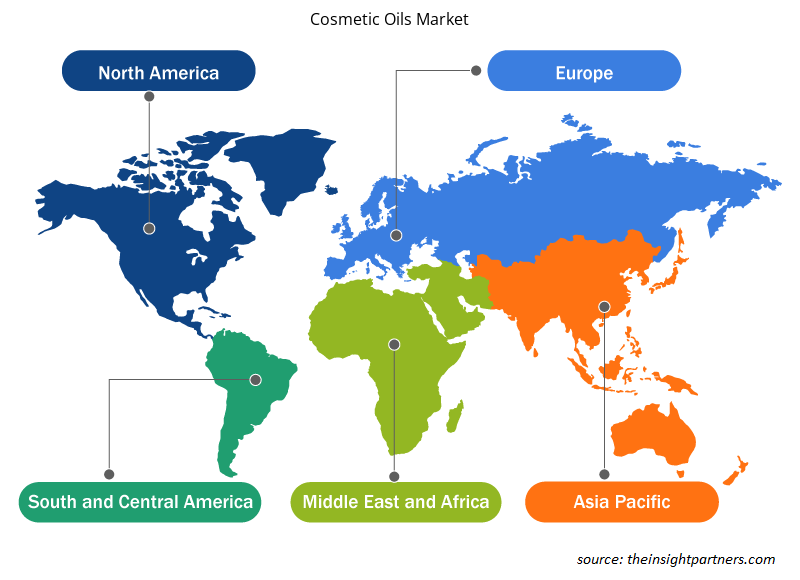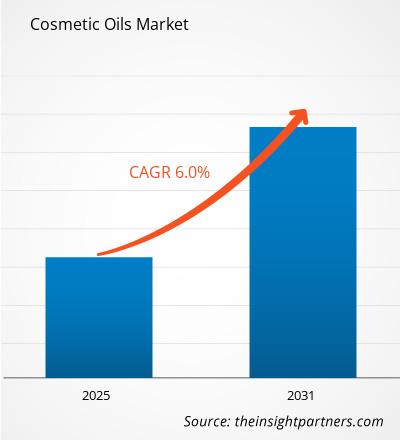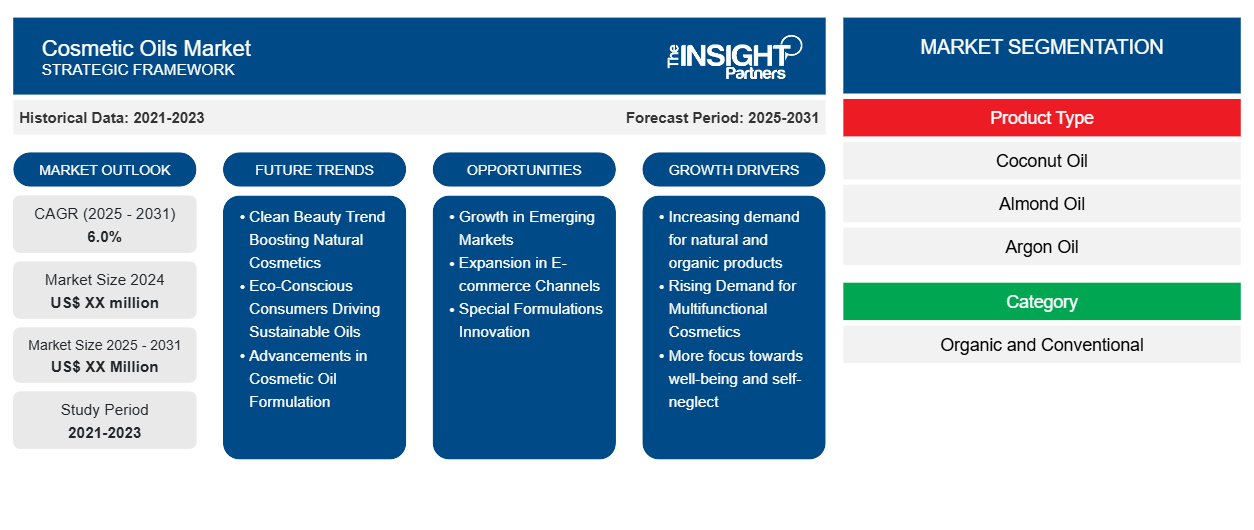预计 2024 年至 2031 年期间化妆油市场的复合年增长率为 6.0%,市场规模将从 2024 年的 XX 百万美元扩大到 2031 年的 XX 百万美元。
化妆品油市场细分为产品类型、类别、分销渠道和地域。根据产品类型,市场细分为椰子油、杏仁油、摩洛哥坚果油、茶树油、荷荷巴油等。根据类别,市场细分为有机和传统。根据分销渠道,市场细分为超市和大卖场、便利店、在线零售等。报告范围涵盖五个地区:北美、欧洲、亚太、中东和非洲、南美和中美洲以及每个地区下的主要国家。全球分析进一步细分为区域和主要国家。报告以美元为单位提供上述分析和细分的价值。
报告目的
The Insight Partners 发布的《化妆品油市场》报告旨在描述当前形势和未来增长、主要驱动因素、挑战和机遇。这将为各种业务利益相关者提供见解,例如:
- 技术提供商/制造商:了解不断变化的市场动态并了解潜在的增长机会,从而能够做出明智的战略决策。
- 投资者:对市场增长率、市场财务预测以及整个价值链中存在的机会进行全面的趋势分析。
- 监管机构:监管市场政策和警察活动,旨在最大限度地减少滥用行为,维护投资者的信任和信心,维护市场的完整性和稳定性。
化妆品油市场细分
产品类型
- 椰子油
- 杏仁油
- 氩油
- 茶树油
- 荷荷巴油
类别
- 有机和传统
分销渠道
- 超市和大卖场
- 便利店
- 网上零售
地理
- 北美
- 欧洲
- 亚太
- 南美洲和中美洲
- 中东和非洲
定制此报告以满足您的需求
您可以免费定制任何报告,包括本报告的部分内容、国家级分析、Excel 数据包,以及为初创企业和大学提供优惠和折扣
- 获取此报告的关键市场趋势。这个免费样品将包括数据分析,从市场趋势到估计和预测。
化妆油市场增长动力
- 对天然和有机产品的需求不断增加:由于消费者越来越意识到含有天然和有机成分的化妆品所带来的好处,对化妆品的需求大幅增长。如今,大多数消费者都意识到美容产品中的成分,并寻求不含有害化学物质的配方。这导致对荷荷巴油、摩洛哥坚果油和椰子油等天然油的需求进一步增加,这些油因其滋养特性和与皮肤的相容性而受到青睐。
- 多功能化妆品需求不断增长:由于消费者更喜欢购买具有多种功效的产品,因此对多功能化妆品的需求不断增长。化妆油也很容易受到这种趋势的影响,因为它们可以用于不同的用途,包括用作护肤或护发化妆品,甚至用作化妆品。这种多功能性使它们极具吸引力,因此推动了它们在各种化妆品配方中的应用。
- 更加注重健康和自我护理:随着健康和自我护理的重要性日益增加,消费者的选择模式也逐渐受到化妆品行业这一趋势的影响。消费者不仅希望自己看起来漂亮,还希望自己感觉良好。被认为具有舒缓和治疗作用的化妆油将吸引那些想要进行自我护理的消费者的注意。
化妆品油市场未来趋势
- 清洁美容趋势推动天然化妆品:清洁美容运动发展迅速,并成为一项利润丰厚的运动,消费者要求所有使用的产品都安全、无毒、环保。因此,品牌在配方中更加依赖天然和有机油,并更加注重原料来源的透明度。对清洁美容的需求不断增长,迫使制造商关注其化妆品油的纯度和可持续性。
- 环保意识强的消费者推动可持续油的使用:随着越来越多的环保意识强的消费者越来越多地投资可持续和合乎道德的化妆品油,品牌必须负责任地采购,以确保成分的可持续性和对当地社区的利益。这种方法效果很好,并引起了环保意识强的消费者的共鸣;因此,它推动了人们对符合这一价值观的产品的需求。
- 化妆品油配方的进步:由于提取和配方技术的进步提高了化妆品油的稳定性,化妆品油的提取和配方可能更加完善。冷压和超临界 CO2 萃取等技术可最大限度地发挥天然油的功效。同时,封装技术可以为制造商提供更多机会来增强油配方中活性成分的输送和吸收,从而进一步激发消费者的兴趣。
化妆油市场机会
- 新兴市场的增长:新兴市场的增长机会在于亚太、拉丁美洲和非洲新兴市场。收入增加及其对可支配收入的分配促进了城市化,改变了人们的审美标准,从而产生了对化妆品(包括精油)的需求。品牌现在可以利用这些区域偏好的产品,并融入特定地区的文化和偏好。
- 电子商务渠道的扩张:电子商务的快速增长为化妆品精油品牌创造了一个极好的机会,使其能够接触到更多的人群。在线购物是一站式解决方案,消费者可以浏览各种各样的产品并选择送货上门。对于品牌来说,这也有助于投资数字营销,通过利用人们对在线美容购物日益增长的需求,有效地推广他们的化妆品精油。
- 特殊配方创新:在与衰老、补水和敏感肌肤相关的领域,特殊用途配方具有巨大的发展空间。品牌可以利用将独特的油和活性成分混合物组合在一起的能力,创造出与特定问题相关的定制化产品,这将满足更多客户的需求,从而增强品牌亲和力。
化妆油市场区域洞察
Insight Partners 的分析师已详尽解释了预测期内影响化妆油市场的区域趋势和因素。本节还讨论了北美、欧洲、亚太地区、中东和非洲以及南美和中美洲的化妆油市场细分和地理位置。

- 获取化妆油市场的区域特定数据
化妆油市场报告范围
| 报告属性 | 细节 |
|---|---|
| 2024 年的市场规模 | XX 百万美元 |
| 2031 年市场规模 | XX 百万美元 |
| 全球复合年增长率(2025 - 2031) | 6.0% |
| 史料 | 2021-2023 |
| 预测期 | 2025-2031 |
| 涵盖的领域 | 按产品类型
|
| 覆盖地区和国家 | 北美
|
| 市场领导者和主要公司简介 |
|
化妆品油市场参与者密度:了解其对业务动态的影响
化妆品精油市场正在快速增长,这得益于消费者偏好的不断变化、技术进步以及对产品优势的认识不断提高等因素导致的终端用户需求不断增加。随着需求的增加,企业正在扩大其产品范围,进行创新以满足消费者的需求,并利用新兴趋势,从而进一步推动市场增长。
市场参与者密度是指在特定市场或行业内运营的企业或公司的分布情况。它表明在给定市场空间中,相对于其规模或总市场价值,有多少竞争对手(市场参与者)存在。
在化妆油市场运营的主要公司有:
- 索菲姆伊比利亚 SL
- 马弗里克石油公司
- 伦克特石油
- 利伯穆斯公司
- OLVEA 植物油
免责声明:上面列出的公司没有按照任何特定顺序排列。

- 了解化妆品油市场顶级关键参与者概况
主要卖点
- 全面覆盖:报告全面涵盖了化妆油市场的产品、服务、类型和最终用户的分析,提供了整体概况。
- 专家分析:报告基于对行业专家和分析师的深入了解而编写。
- 最新信息:该报告涵盖了最新信息和数据趋势,确保了其与业务的相关性。
- 定制选项:此报告可以定制以满足特定客户要求并恰当地适应业务策略。
因此,化妆品油市场研究报告有助于引领解读和了解行业情景和增长前景。尽管可能存在一些合理的担忧,但本报告的总体优势往往大于劣势。
- 历史分析(2 年)、基准年、预测(7 年)及复合年增长率
- PEST和SWOT分析
- 市场规模、价值/数量 - 全球、区域、国家
- 行业和竞争格局
- Excel 数据集
近期报告
相关报告
客户评价
购买理由
- 明智的决策
- 了解市场动态
- 竞争分析
- 客户洞察
- 市场预测
- 风险规避
- 战略规划
- 投资论证
- 识别新兴市场
- 优化营销策略
- 提升运营效率
- 顺应监管趋势





















 获取免费样品 - 化妆油市场
获取免费样品 - 化妆油市场